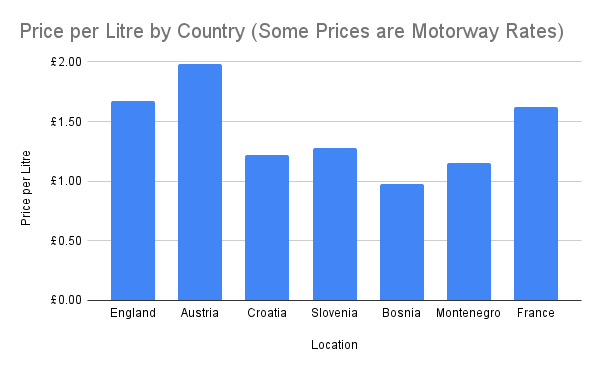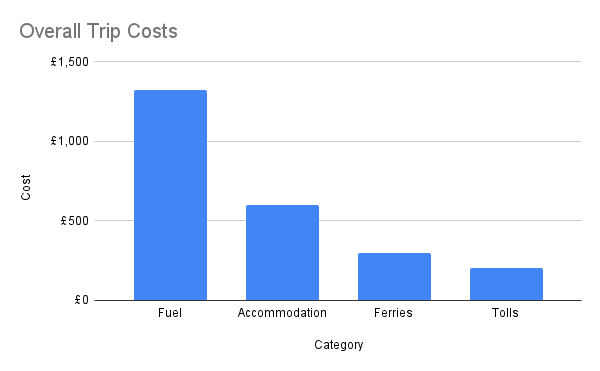Overlanding is cheap, right?
Not really—not if you buy all the gear that’s supposedly "essential." Truth is, you don’t need that much, but what you can’t avoid are the day-to-day expenses: fuel, tolls, ferries, food, and camp fees.
So, having completed our 25-day trip to Montenegro, what did we actually spend?
We passed through eight countries and covered a lot of miles getting from Scotland to the Balkans: England, France, Germany, Austria, Slovenia, Croatia, Bosnia and Herzegovina, and finally, Montenegro. England was done in a day—so were Germany and Austria—but that doesn’t mean it didn’t cost anything.
Fuel
Fuel is expensive in Europe, especially at motorway services. I paid £1.67/litre at one service station close to London and €2.24/litre in Austria. Expensive! There are fuel price apps that help you find cheaper fuel on a map and navigate there, but we were dashing across Europe, and I just wanted to get there. I was still shocked at some of the prices, though. Thankfully, once we got into the Balkans, fuel was much cheaper—the lowest we paid was around £0.95/litre in Bosnia.
Our total fuel bill for the trip was £1,321. The chart below shows the prices we paid during the trip:
Ferries
Our return ferry across the Channel cost £300. I would have preferred the overnight ferry from Newcastle, which would have cut out a lot of driving, but since it was the summer holidays, the price was an astronomical £2,400!
Had we taken the Channel Tunnel, the best price we could have got was £600. There’s plenty of spare capacity on the tunnel, so it’s a shame they insist on doubling prices over the holiday period. The tunnel is definitely more convenient than the Dover–Calais ferry, but for a £300 saving, I was happy to take the boat.
Road Tolls
Tolls are an interesting one. They can be avoided fairly easily by taking the back roads. Travelling the road less travelled is a big part of overlanding, but when you're crossing a continent, all that extra time adds up.
If I were retired and time was no object, I would’ve enjoyed taking a week to get to the Balkans and seeing a few sights along the way. But we only had three weeks for the entire trip, and I wanted to spend as much time as possible in Montenegro—so we had to suck up the tolls.
In total, we spent £201 on tolls. French tolls cost £76 (one way—we came back through Germany and Belgium to avoid paying again). Austria, which we passed through twice, cost £35. The remainder—£90—was in Croatia.
Croatian tolls seem high, but they're charged at a similar rate to the French ones. Ours were all clocked up on the A1 motorway, which runs north to south. We dropped on and off that road at various points during the trip.
The Croatian back roads are slow, to say the least. The terrain is mostly mountainous, so straight roads are a rarity. Coastal routes are more densely populated and busy, bristling with speed cameras and low speed limits. The extra time taken to travel the back roads is significant—more than double, in fact.
So, if you want to get anywhere in Croatia and time is precious, you'll have to suck up the odd toll. The scenery along the back roads is spectacular—but then, so it is along much of the A1.
Camp Fees
We set out intending to avoid camp fees where we could, but circumstances meant we ended up doing very little wild camping.
The first night we camped in a French aire after crossing the Channel—that was free, of course. Aires are rest stops along French motorways. It’s free to sleep overnight at these, and while some are full-service stops with fuel, food, showers, etc., others are just basic lay-bys, usually with a toilet and little else.
They aren’t exactly picturesque, sitting right next to a motorway, but if you're arriving late and leaving early, they beat spending €20–60 on campsite facilities you’ll hardly use. Tent campers might want to avoid them as there may be nowhere suitable to pitch, but for vehicle campers like us, they’re a great option.
Campsites on the way to the Balkans were chosen more for their proximity and cost than their beauty. On our second night, we stayed at a fully automated site in Germany near the Austrian border, at the foot of the Alps. We paid €30 at a machine, which spat out a card giving us access to the bathrooms and showers. There was even a pizza vending machine!
We chickened out of the auto-pizza in the end—somehow I just imagined rows of Dr. Oetker frozen pizzas stacked like 7” singles in a jukebox. Instead, we walked into the local village and ate at a pub. Next door was a hall where local dancers were practicing—girls twirling in weighted skirts, boys stamping and slapping their lederhosen. It was like stepping back in time. Great to see—once we stopped sniggering.
Once we got into Slovenia and Croatia, we paid more attention to the campsites, looking for a bit more wow factor. Prices along the coast were fairly high—around €50 a night for the five of us, the Grenadier, and the trailer. Some sites were much more expensive, but those tended to offer facilities we neither needed nor wanted.
We prefer quiet, clean sites in beautiful locations rather than massive parking lots for huge white campervans, even if the facilities are better. In Bosnia, sites were much cheaper—about £15 a night. The two we stayed at were very different: the first was nice; the second, not so much.
Due to two of the kids getting sick while we were in Bosnia—and some unseasonably low nighttime temperatures—we stayed in rented accommodation for five nights while in the Montenegrin highlands. This cost no more per night than the Croatian campsites. Once we got back to the coast, we switched back to camping.
Overall, we spent around £600 on campsites and accommodation.
Day to Day Expenses
I don’t have a precise figure on these but we were sensible with what we spent, The Balkans in general are cheaper than Western Europe for food and other day to day expenses. A restaurant meal for the five of us could be had for around €60 in the mountains, down on the coast around Kotor or Dubrovnic prices are closer to those back home. That said they are still cheaper than you might find on the Cote d’Azur - a similarly attractive location.
Total Cost
All in we spent around £3400, £2400 of that is described above, the rest was spent on activities: Zipline €40 each and rafting €80 each, and food, plus the occasional treat for the kids.
Could We Have Done It Cheaper?
Yes—we could have taken more back roads, saved on tolls... but then the extra fuel, time, and likely accommodation costs would have probably eaten up any savings.
We could have avoided motorway services and bought fuel off the beaten track, which might have saved a little, but not much once you consider the detours and time. I did try to fill up before getting onto motorways anyway—we were only caught out a couple of times.
We could have saved on accommodation by wild camping where possible, but realistically the only areas we might have done that were in the highlands, where overnight temperatures were so low it would have been miserable for the kids.
We could have saved on food by eating out less and cooking more meals at camp, supermarkets are noticeably cheaper in the Balkans, A bag of shopping costs around half what it does in the UK.
Final Thoughts:
Overlanding can be cheap—but not necessarily. There’s always a balance between cost, comfort, and convenience. We made choices that worked best for our time frame and situation, and despite the costs, it was absolutely worth it.




